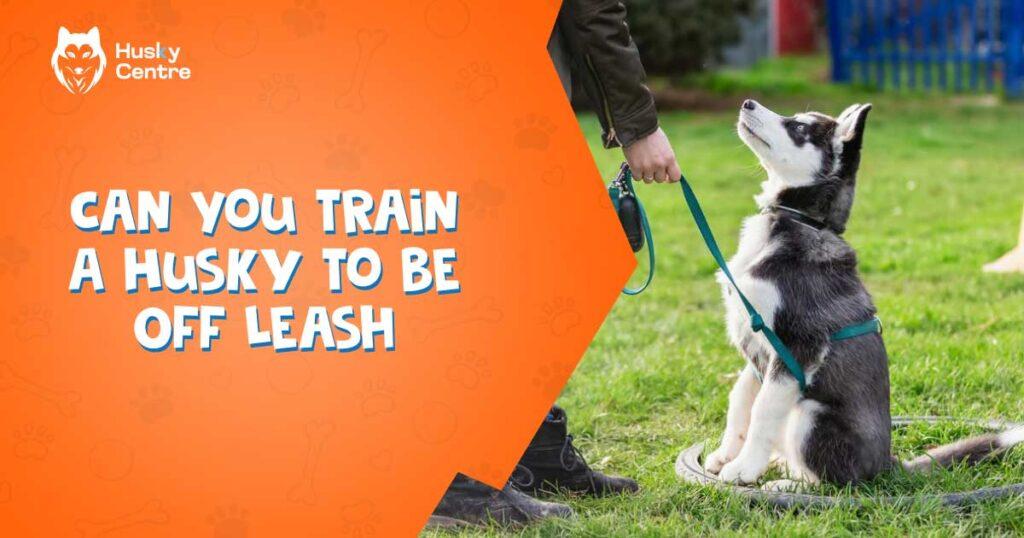Yes, you can train a Husky to be off-leash. It requires consistent training, patience, and strong recall commands.
Huskies are known for their independent nature and high energy levels. Training them to be off-leash can be challenging but achievable. Start with basic obedience training to establish a strong foundation. Gradually introduce off-leash exercises in a controlled environment. Use positive reinforcement to encourage good behavior and recall.
Always ensure the area is safe and secure. Regular practice and patience are key to success. Building a strong bond with your Husky enhances training effectiveness. Off-leash training not only promotes freedom but also strengthens trust between you and your pet. With dedication, your Husky can learn to enjoy off-leash adventures responsibly.
Understanding The Husky Breed
Huskies are known for their striking looks and vibrant personalities. Training a Husky to be off-leash is a topic that many dog owners ponder. Understanding the breed is crucial for success. This section delves into the unique traits and instincts of Huskies to help you comprehend their behaviors better.
Characteristics And Temperament
Huskies are medium-sized, working dogs with a distinct appearance. Their thick double coat keeps them warm in cold climates. They often have striking blue or multicolored eyes and unique facial masks.
Here are some key characteristics:
- Friendly and Gentle: Huskies are known for their friendly nature. They are not aggressive and usually get along well with children and other dogs.
- Energetic and Playful: These dogs have high energy levels. They love to run, play, and need regular exercise.
- Independent and Stubborn: Huskies can be quite independent. They may show stubbornness during training sessions.
Temperament-wise, Huskies are known for their lively and outgoing nature. They are generally not aggressive but can be quite mischievous. They enjoy human company and can suffer from separation anxiety if left alone for too long. Training requires patience due to their independent streak.
Natural Instincts And Behavior
Understanding a Husky’s natural instincts is vital for effective training. Huskies were originally bred as sled dogs in cold regions, which means they have certain ingrained behaviors.
- Strong Prey Drive: Huskies have a strong prey drive. They may chase small animals if not trained properly.
- Love for Running: These dogs love to run. It’s in their nature to cover long distances, making them prone to wandering off if off-leash.
- Pack Mentality: Huskies are pack animals. They enjoy being part of a group and can be very social.
Due to their strong prey drive, Huskies may find it hard to resist chasing squirrels, cats, or other small animals. This makes off-leash training challenging. Their instinct to run can lead them to roam far from home if not properly contained or trained.
To summarize, understanding these natural instincts is crucial. It helps in devising effective training strategies to manage their behavior and ensure safety while off-leash.
Challenges Of Training A Husky To Be Off-leash
Huskies are beautiful and intelligent dogs known for their striking looks and energetic nature. Training a Husky to be off-leash can be challenging due to their unique characteristics. Understanding these challenges is crucial to developing effective training strategies.
High Prey Drive
Huskies have a strong prey drive, making them chase small animals. This instinct comes from their history as sled dogs in the Arctic.
Challenges related to high prey drive include:
- Chasing squirrels, rabbits, and other small animals
- Ignoring commands when they see potential prey
- Running long distances quickly to catch the prey
To manage this, focus on consistent training and use positive reinforcement. Reward your Husky for obeying commands even when distracted. Keep training sessions short and frequent to maintain their interest.
Independence And Stubbornness
Huskies are known for their independence and stubbornness. They often decide for themselves if they want to follow commands.
Signs of independence and stubbornness:
- Ignoring commands
- Choosing to explore rather than return
- Testing boundaries regularly
To address this, establish yourself as the pack leader. Use firm, clear commands and be consistent with rules. Training should start early, as young Huskies are more adaptable. Patience and persistence are key.
Energy Levels And Wanderlust
Huskies have high energy levels and a strong wanderlust. They love to explore new environments and can run for miles without getting tired.
Challenges due to energy and wanderlust:
- Running away to explore new areas
- Requiring extensive exercise to stay calm
- Escaping from yards or enclosures
Ensure your Husky gets plenty of physical activity. Long walks, runs, and play sessions help burn off their energy. Additionally, mental stimulation through training and puzzle toys keeps them engaged. Creating a safe, enclosed space for off-leash play can also help.
Importance Of Early Training And Socialization
Training a Husky to be off-leash can be challenging but rewarding. Huskies are known for their independent nature and strong prey drive. Therefore, early training and socialization are crucial for success. Teaching your Husky the right behaviors from a young age sets the foundation for a well-behaved adult dog. Socializing them with other dogs and people helps them become confident and well-adjusted. Let’s dive into the key aspects of early training and socialization.
Puppy Training Basics
Starting with the basics of puppy training is essential. The first step is to establish a routine. Huskies thrive on consistency. Create a schedule for feeding, potty breaks, and training sessions. This helps your Husky understand what to expect and reduces anxiety.
Focus on basic commands such as sit, stay, come, and leave it. These commands are the building blocks for more advanced training. Use positive reinforcement techniques like treats and praise to encourage good behavior. Avoid punishment as it can lead to fear and aggression.
- Sit: Helps in controlling impulsive behavior.
- Stay: Teaches patience and control.
- Come: Crucial for off-leash reliability.
- Leave it: Prevents unwanted behaviors.
Training sessions should be short and fun. Puppies have a short attention span, so keep sessions under 10 minutes. Gradually increase the duration as they grow older.
Socializing With Other Dogs And People
Socialization is a critical component of early training. Exposing your Husky to different environments, people, and other dogs helps them become well-rounded adults. Start socialization as early as 8 weeks old.
Organize playdates with other puppies. This teaches your Husky how to interact properly with their peers. Supervised play helps them learn bite inhibition and social cues. Introduce them to various types of people, including children, men, and women. This reduces fear and aggression towards strangers.
Take them to different environments like parks, pet-friendly stores, and busy streets. This helps them adapt to various sights, sounds, and smells. Use a leash initially to ensure safety. Gradually, as they become more confident, introduce off-leash play in secure, enclosed areas.
- Playdates teach social skills.
- Meeting different people reduces fear.
- Exposure to new environments builds confidence.
Always supervise interactions to prevent negative experiences. Positive socialization experiences are crucial for a well-adjusted Husky.
Establishing Good Habits Early
Establishing good habits early sets the tone for your Husky’s behavior as an adult. Consistency is key. Set clear rules and enforce them consistently. If you don’t want your Husky on the furniture, never allow it, even as a puppy.
Create a designated potty area and stick to it. This helps in housebreaking. Praise and reward your Husky for using the designated spot. Avoid punishing accidents as it can create fear around potty time.
Crate training is also beneficial. It provides a safe space for your Husky and aids in housebreaking. Make the crate a positive place by using treats and toys.
| Habit | Benefit |
| Consistent Rules | Prevents confusion and unwanted behavior. |
| Designated Potty Area | Aids in housebreaking. |
| Crate Training | Provides a safe space and aids in housebreaking. |
Incorporate daily exercise and mental stimulation into your routine. Huskies are high-energy dogs that require regular physical activity. Mental stimulation through puzzle toys and training games keeps their minds sharp.
By establishing good habits early, you set the foundation for a well-behaved and happy Husky.
Steps To Train A Husky To Be Off-leash
Training a Husky to be off-leash can be a rewarding experience. This breed is known for its intelligence and energy. Successfully training a Husky requires patience and consistency. Here are the steps to train a Husky to be off-leash.
Building A Strong Recall Command
Recall command is the cornerstone of off-leash training. Start by teaching your Husky to come when called. Use a distinct word like “Come” or “Here”. Ensure you practice this in a controlled environment.
Follow these steps:
- Start Indoors: Begin training in a quiet room with no distractions.
- Use Treats: Call your Husky and reward them with a treat when they come to you.
- Short Distances: Start with short distances and gradually increase.
- Practice Daily: Repetition is key. Practice multiple times a day.
Common mistakes to avoid:
- Calling your dog when they are distracted.
- Using a harsh tone.
- Not rewarding immediately.
Positive Reinforcement Techniques
Positive reinforcement is essential in training a Husky. This technique involves rewarding your dog for good behavior. This encourages them to repeat the behavior.
Methods include:
- Treats: Use small, tasty treats.
- Praise: Verbal praise and petting.
- Play: Use playtime as a reward.
- Identify desired behavior: Decide what behaviors you want to reinforce.
- Reward immediately: Give rewards right after the behavior occurs.
- Be consistent: Reward every time the behavior is performed.
- Use high-value treats that your Husky loves.
- Keep training sessions short and fun.
Gradual Introduction To Off-leash Environments
Gradually introducing your Husky to off-leash environments is crucial. This helps them adjust and understand boundaries. Start in a safe, enclosed area.
- Begin in a fenced yard: This provides safety and control.
- Use a long leash: This gives your dog freedom while you still have control.
- Increase distractions: Slowly introduce distractions to test recall command.
- Ensure your Husky is calm before starting.
- Always have treats or rewards ready.
- Rushing the process.
- Skipping steps.
Using A Long Leash For Training
A long leash is an excellent tool for off-leash training. It allows your Husky to explore while you maintain control. This builds trust and reinforces commands.
- Choose the right leash: A 30-foot leash is ideal.
- Start in a controlled environment: Use a fenced yard initially.
- Practice recall: Call your Husky and reel them in gently.
- Provides safety while training.
- Allows gradual increase in freedom.
- Always supervise your dog during training.
- Use a harness to prevent neck strain.
By following these steps, you can successfully train your Husky to be off-leash. Consistency, patience, and positive reinforcement are key.
Tools And Techniques For Off-leash Training
Training a Husky to be off-leash can be challenging due to their independent nature. Using the right tools and techniques can make this task manageable. This section explores different methods to help you achieve off-leash success with your Husky.
Clicker Training
Clicker training is a popular method for teaching dogs off-leash skills. The clicker is a small device that makes a distinct sound. This sound marks the exact moment your dog performs a desired behavior.
Here’s how to use clicker training effectively:
- Introduce the Clicker: Click and give your Husky a treat. Repeat until your dog associates the click with a reward.
- Command Association: Use a command like “come” and click the moment your Husky starts moving towards you. Reward immediately.
- Practice in Safe Areas: Start in a fenced yard or quiet park. Gradually increase distractions as your dog gets better.
Consistency is key. Regular practice sessions ensure your Husky understands the command. Clicker training not only helps with off-leash training but also strengthens your bond with your dog.
Treats And Rewards
Using treats and rewards is crucial for motivating your Husky. Positive reinforcement encourages your dog to repeat good behavior. Here are some tips:
- High-Value Treats: Use treats your Husky loves. This can be bits of chicken, cheese, or commercial dog treats.
- Timing: Give the treat immediately after the desired behavior. This helps your dog understand what earns the reward.
- Verbal Praise: Combine treats with verbal praise like “Good job!” This enhances the positive experience.
Creating a reward system can be effective. For instance, use a table to track progress:
| Behavior | Reward |
| Responds to “Come” | High-Value Treat |
| Stays Close | Verbal Praise |
| Ignores Distractions | Extra Playtime |
Using treats and rewards consistently helps your Husky learn faster and makes off-leash training enjoyable.
Consistent Commands And Signals
Consistency in commands and signals is vital for off-leash training. Clear communication prevents confusion and reinforces learning.
Follow these steps for consistent training:
- Use the Same Commands: Stick to one word or phrase for each command. For example, always use “come” for recall.
- Hand Signals: Pair verbal commands with hand signals. This helps in noisy environments where your dog might not hear you.
- Practice Regularly: Train daily to reinforce commands. Short, frequent sessions are more effective than long, infrequent ones.
Creating a routine can also help. For instance, use a table to schedule training sessions:
| Day | Command | Duration |
| Monday | Come | 10 minutes |
| Wednesday | Stay | 10 minutes |
| Friday | Heel | 10 minutes |
Consistency in commands and signals builds trust and ensures your Husky understands what is expected.
Gps Collars And Tracking Devices
GPS collars and tracking devices are essential for off-leash training. They provide peace of mind and ensure your Husky’s safety.
Here are some benefits:
- Real-Time Tracking: Know your Husky’s location at all times. This is crucial if your dog wanders off.
- Geofencing: Set virtual boundaries. Get alerts if your Husky leaves the designated area.
- Activity Monitoring: Track your dog’s activity levels. Ensure they are getting enough exercise.
Choosing the right device is important. Consider the following features:
| Feature | Importance |
| Battery Life | High |
| Range | Medium |
| Durability | High |
Investing in a reliable GPS collar ensures your Husky’s safety during off-leash adventures. Combining these devices with proper training creates a safe and enjoyable experience for both you and your dog.
Safety Considerations
Training a Husky to be off-leash is a rewarding yet challenging task. Huskies are known for their independent and adventurous spirit. Safety considerations are paramount when allowing your Husky the freedom to roam off-leash. Ensuring their safety is crucial to prevent accidents and ensure a positive experience for both owner and pet.
Ensuring A Secure Environment
To train your Husky off-leash, creating a secure environment is essential. A well-fenced yard is the best place to start. Make sure the fence is high enough; Huskies are excellent jumpers and climbers.
Another option is an enclosed dog park. These spaces are designed to be safe and allow your dog the freedom to explore without the risk of running away.
- Check the fence for gaps – Ensure there are no holes or weak spots.
- Use a GPS tracker – Attach a GPS tracker to your Husky’s collar to monitor their location.
- Supervise at all times – Always keep an eye on your dog, even in a secure environment.
These precautions help create a safe space for your Husky to enjoy their off-leash time. Remember, a secure environment is the first step to successful off-leash training.
Identifying And Avoiding Hazards
While training your Husky off-leash, it’s important to identify and avoid potential hazards. Being aware of your surroundings can prevent accidents and ensure your dog’s safety.
Some common hazards include:
| Hazard | Action |
| Busy roads | Keep your Husky away from traffic-heavy areas. |
| Wild animals | Avoid areas known for wildlife to prevent encounters. |
| Poisonous plants | Learn to identify and steer clear of toxic vegetation. |
Always carry a first-aid kit and familiarize yourself with basic first-aid procedures for dogs. This preparation can make a significant difference in handling emergencies.
Emergency Recall Command
An emergency recall command is a lifesaver in critical situations. Training your Husky to respond immediately can prevent dangerous scenarios.
Start by choosing a unique word or phrase that you only use for emergencies. This command should stand out from regular commands and catch your dog’s attention instantly.
- Choose a command – Pick a unique word or phrase.
- Practice in a controlled environment – Begin training in a quiet, enclosed space.
- Use high-value rewards – Offer your Husky their favorite treats when they respond correctly.
- Gradually increase distractions – Slowly introduce more distractions while practicing the command.
- Be consistent and patient – Consistency is key to successful training.
Repeating these steps regularly reinforces the command. With time, your Husky will learn to respond reliably, ensuring their safety in emergencies.
Realistic Expectations And Limitations
Training a Husky to be off-leash is a challenging but rewarding endeavor. Realistic expectations and limitations play a crucial role in this journey. Huskies are known for their independent and adventurous nature, which can make off-leash training difficult but not impossible. Understanding these factors can help set achievable goals and ensure the safety and happiness of your furry friend.
Assessing Your Husky’s Progress
Monitoring your Husky’s progress is essential for successful off-leash training. Regular assessments help determine if your Husky is ready for the next step or needs more practice. Here are some key points to consider:
- Recall Ability: Does your Husky respond to their name and come back when called?
- Distraction Management: Can they ignore distractions like other animals, people, or noises?
- Consistency: Is their behavior consistent across different environments?
- Duration: How long can they stay focused and follow commands?
Tracking progress can be easier with a simple table:
| Criteria | Rating (1-5) |
| Recall Ability | 4 |
| Distraction Management | 3 |
| Consistency | 4 |
| Duration | 2 |
Regularly update the table to see improvements or identify areas needing more work. Positive reinforcement like treats and praise can motivate your Husky and make training enjoyable.
Understanding Breed-specific Limitations
Huskies have unique traits that can impact off-leash training. Understanding these limitations can help tailor your approach:
- High Prey Drive: Huskies may chase small animals, making recall challenging.
- Independent Nature: They are known for their stubbornness and may not always follow commands.
- Strong Wanderlust: Huskies love to explore and can wander off if not properly trained.
- Energy Levels: They require a lot of physical activity to stay focused.
Breed-specific training techniques can help address these challenges:
- Leash Training: Start with leash training to build a strong foundation.
- Recall Games: Play recall games to make coming back fun.
- Controlled Environments: Practice in fenced areas before moving to open spaces.
- Regular Exercise: Ensure they get enough physical activity to reduce excess energy.
Recognizing these traits helps in setting realistic expectations and creating a tailored training plan.
Knowing When Off-leash Is Not Suitable
There are situations where off-leash might not be the best option for your Husky. Safety should always come first. Here are some scenarios where off-leash might not be suitable:
- High-Traffic Areas: Locations with a lot of cars or people can be dangerous.
- Unfamiliar Environments: New places can be overwhelming and distracting.
- Presence of Wildlife: Areas with wildlife can trigger their prey drive.
- Incomplete Training: If your Husky hasn’t mastered recall, off-leash is risky.
Assessing the environment is crucial. Here’s a simple checklist:
| Environment | Suitability |
| Park | Suitable |
| Beach | Suitable |
| Busy Street | Not Suitable |
| Woods with Wildlife | Not Suitable |
Using this checklist ensures your Husky’s safety and helps in making informed decisions. Always prioritize the well-being of your pet over the desire for off-leash freedom.
Frequently Asked Questions
Can Huskies Be Good Off Leash?
Huskies can struggle off leash due to their strong prey drive and independent nature. Training and supervision are essential.
Can You Train A Husky Not To Pull On Leash?
Yes, you can train a husky not to pull on the leash. Use positive reinforcement, consistent commands, and patience.
Are Huskies The Hardest Dog To Train?
Huskies can be challenging to train due to their independent nature. Consistent training and patience are essential. They require experienced handlers to manage their energy and intelligence effectively. Early socialization helps.
Can Huskies Be Trained To Not Run Away?
Yes, Huskies can be trained not to run away. Consistent training, secure fencing, and mental stimulation are key. Use positive reinforcement and establish boundaries early. Socialization and regular exercise also help keep them content and less likely to escape.
Conclusion
Training a Husky to be off-leash is challenging but possible with patience and consistency. Understanding their nature is key. Always use positive reinforcement and regular practice. Start in a safe, enclosed area before progressing. With time and effort, your Husky can enjoy off-leash freedom responsibly.


Meet Jarred, the heart and soul behind HukyCentre. With a deep affection for furry friends, he pours his passion into every word he writes. His genuine love for dogs shines through in his engaging and informative content. As a dedicated dog enthusiast, Jarred’s goal is to share valuable insights and tips that resonate with fellow dog lovers. Join Jarred on the journey as he celebrates the joy and companionship that dogs bring into our lives.



